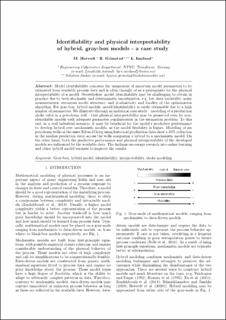| dc.contributor.author | Hotvedt, Mathilde | |
| dc.contributor.author | Grimstad, Bjarne Andre | |
| dc.contributor.author | Imsland, Lars Struen | |
| dc.date.accessioned | 2022-10-17T12:24:09Z | |
| dc.date.available | 2022-10-17T12:24:09Z | |
| dc.date.created | 2021-11-26T15:14:25Z | |
| dc.date.issued | 2021 | |
| dc.identifier.citation | IFAC-PapersOnLine. 2021, 54 (3), 389-394. | en_US |
| dc.identifier.issn | 2405-8963 | |
| dc.identifier.uri | https://hdl.handle.net/11250/3026412 | |
| dc.description.abstract | Model identifiability concerns the uniqueness of uncertain model parameters to be estimated from available process data and is often thought of as a prerequisite for the physical interpretability of a model. Nevertheless, model identifiability may be challenging to obtain in practice due to both stochastic and deterministic uncertainties, e.g. low data variability, noisy measurements, erroneous model structure, and stochasticity and locality of the optimization algorithm. For gray-box, hybrid models, model identifiability is rarely obtainable due to a high number of parameters. We illustrate through an industrial case study – modeling of a production choke valve in a petroleum well – that physical interpretability may be preserved even for non-identifiable models with adequate parameter regularization in the estimation problem. To this end, in a real industrial scenario, it may be beneficial for the model’s predictive performance to develop hybrid over mechanistic models, as the model flexibility is higher. Modeling of six petroleum wells on the asset Edvard Grieg using historical production data show a 35% reduction in the median prediction error across the wells comparing a hybrid to a mechanistic model. On the other hand, both the predictive performance and physical interpretability of the developed models are influenced by the available data. The findings encourage research into online learning and other hybrid model variants to improve the results. | en_US |
| dc.language.iso | eng | en_US |
| dc.publisher | Elsevier | en_US |
| dc.rights | Attribution-NonCommercial-NoDerivatives 4.0 Internasjonal | * |
| dc.rights.uri | http://creativecommons.org/licenses/by-nc-nd/4.0/deed.no | * |
| dc.title | Identifiability and physical interpretability of hybrid, gray-box models - a case study | en_US |
| dc.type | Journal article | en_US |
| dc.type | Peer reviewed | en_US |
| dc.description.version | acceptedVersion | en_US |
| dc.source.pagenumber | 389-394 | en_US |
| dc.source.volume | 54 | en_US |
| dc.source.journal | IFAC-PapersOnLine | en_US |
| dc.source.issue | 3 | en_US |
| dc.identifier.doi | 10.1016/j.ifacol.2021.08.273 | |
| dc.identifier.cristin | 1959906 | |
| cristin.ispublished | true | |
| cristin.fulltext | postprint | |
| cristin.qualitycode | 1 | |

